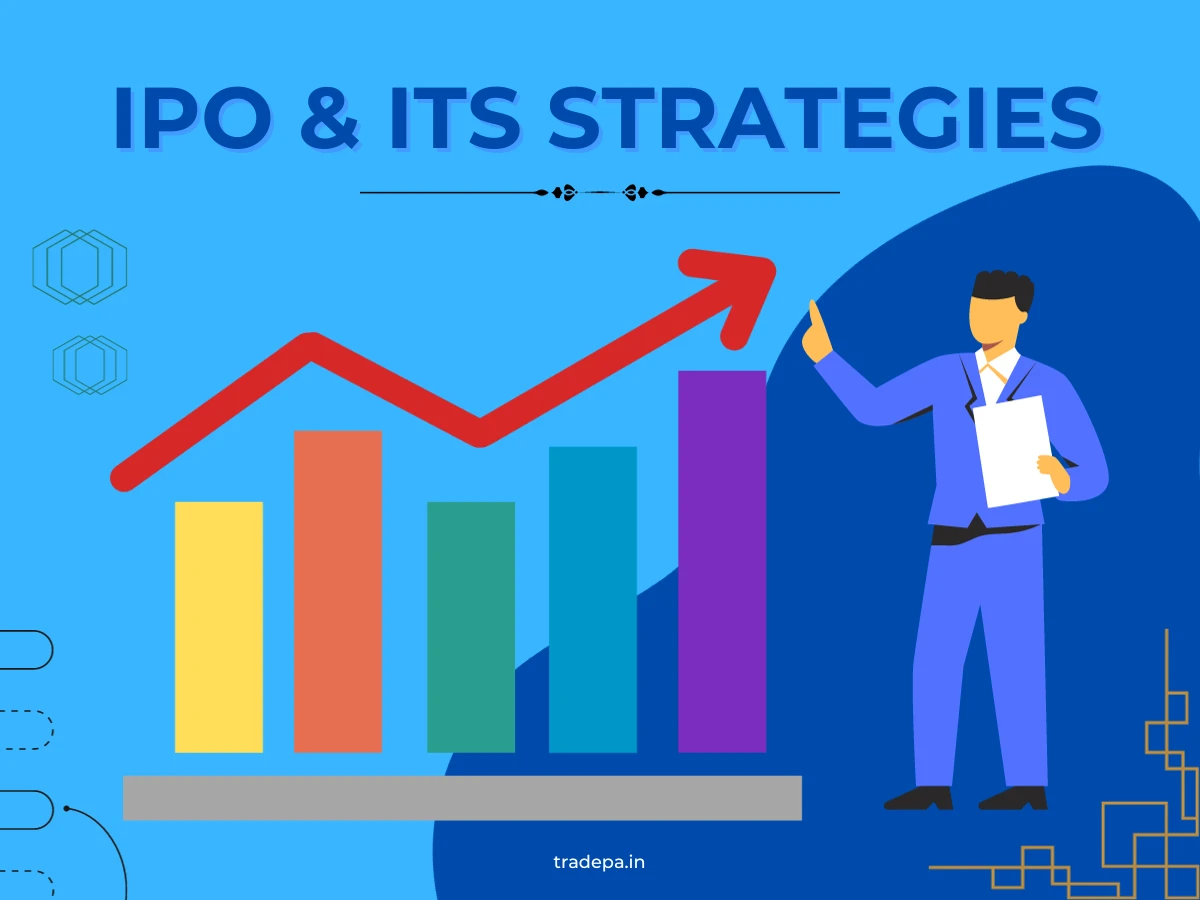What is Initial Public Offer IPO and its investment strategies

An Initial Public Offering (IPO) signifies a crucial milestone in a company’s journey, transitioning from being privately held to becoming publicly traded on a stock exchange. Understanding this essential financial event is pivotal for anyone venturing into the world of investments. An IPO enables a company to offer its shares to the public for the first time, opening its ownership to a broader pool of investors. This process generates capital for the company and provides opportunities for individuals to invest in potentially promising ventures.
At its core, an IPO represents the initial stock sale by a private company to the public. Before an IPO, a company operates privately, usually with few investors, including founders, early employees, and venture capitalists. When a company decides to go public, it aims to raise capital by offering shares to the public through a stock exchange. Companies often pursue this step to fuel growth, expand operations, pay off debts, or fund research and development initiatives.
Understanding Initial Public Offerings (IPOs)
Comprehending the mechanics of an IPO involves navigating through several steps. First, the company collaborates with investment banks or underwriters, who help determine the IPO price and the number of shares to be offered to the public. Subsequently, a prospectus is drafted, providing comprehensive details about the company’s operations, financial performance, risks, and prospects. Investors use this document to evaluate whether they want to participate in the IPO.
The evolution of IPOs has had a profound impact on the investment landscape. Over the years, IPOs have gained attention for showcasing high-growth potential companies like technology startups and innovative enterprises. They provide investors with an opportunity to enter the inception stage of a company that could become the next industry leader. The importance of IPOs in the investment world extends beyond just a chance to invest; it signifies market innovation, economic growth, and the potential for substantial returns for investors willing to take calculated risks.
IPO Fundamentals
In India, Initial Public Offerings (IPOs) function similarly to IPOs worldwide but within the regulatory framework set by the Securities and Exchange Board of India (SEBI). An IPO in India marks the transition of a privately held company to a publicly traded entity, enabling it to raise capital by offering shares to the public through various stock exchanges like the Bombay Stock Exchange (BSE) and the National Stock Exchange (NSE).
Process Breakdown: How IPOs Work
The process of conducting an IPO in India involves several distinct stages. Companies aspiring to go public collaborate with merchant bankers and legal advisors to initiate the IPO journey. These entities assist in the drafting of the Red Herring Prospectus, which provides comprehensive details about the company’s operations, financials, risks, and objectives.
The prospectus undergoes submission to SEBI for approval. Once approved, the company sets the IPO price, allocates shares, and opens the offering to institutional and retail investors during the subscription period. Post-subscription, the company lists its shares on the stock exchange, allowing investors to trade them freely.
Parties Involved in IPOs
In the Indian IPO, various entities play pivotal roles. Companies seeking to go public work alongside merchant bankers, legal advisors, and underwriters to ensure compliance with SEBI regulations and a successful offering. Additionally, regulatory bodies like SEBI oversee the IPO process, ensuring adherence to disclosure norms and investor protection.
Investors in Indian IPOs range from institutional investors, including mutual funds and foreign institutional investors, to retail investors. Their participation is crucial in determining the success and reception of an IPO in the Indian market.
Regulatory Landscape and Compliance
SEBI regulates Indian IPOs, ensuring companies comply with stringent disclosure norms, governance standards, and pricing guidelines. SEBI’s oversight aims to protect investor interests, maintain market integrity, and promote transparency within the Indian capital markets. Understanding SEBI regulations is essential for companies and investors engaging in Indian IPOs to navigate the IPO process seamlessly and ensure compliance.
Pros and Cons of IPO
| PROS | CONS |
|---|---|
| Potential for High Returns | High Volatility and Risk Factors |
| Early Access to Promising Companies | Limited Historical Data |
| Market Enthusiasm and Publicity | Lock-Up Periods and Insider Selling |
Pros of Investing in IPOs
- Potential for High Returns: Investing in IPOs offers the potential for substantial returns, primarily when investing in companies with promising growth prospects. Early backers of successful IPOs often benefit from the initial surge in stock prices as the company garners market attention.
- Early Access to Promising Companies: Participating in an IPO allows investors to be part of a company’s journey right from its nascent stage. This early access will enable investors to potentially capitalize on the growth trajectory of innovative and high-potential enterprises.
- Market Enthusiasm and Publicity: IPOs often generate substantial market enthusiasm and publicity, attracting attention from analysts, media, and investors. This heightened visibility can create a buzz around the company, potentially leading to increased demand for its shares during the offering.
Cons of Investing in IPOs
- High Volatility and Risk Factors: The initial phase following an IPO can witness significant volatility in stock prices. Market fluctuations and investor sentiments can cause price swings, presenting risks for investors, especially in the short term.
- Limited Historical Data: One challenge with IPOs is the limited historical data available for analysis. Unlike established companies with a track record in the public market, IPOs lack extensive historical financial information, making it challenging to assess their long-term performance accurately.
- Lock-Up Periods and Insider Selling: After an IPO, insiders and early investors may be subject to lock-up periods, restricting them from selling their shares immediately. However, insider selling can impact the stock price when these lock-up periods expire as additional shares flood the market, potentially causing downward pressure on prices. Understanding these factors is crucial for investors considering IPOs to make informed investment decisions.
Strategies for IPO Investing

I. Analyzing Company Filings and Prospectus
Conducting thorough research involves delving into the company’s filings and prospectus. This document offers insights into the company’s financial health, business model, risk factors, and future plans. Analyzing these details aids in assessing the company’s viability as an investment option.
II. Understanding Market Conditions
Understanding the prevailing market conditions is essential before investing in an IPO. Factors like economic trends, industry outlook, and market sentiment significantly impact an IPO’s performance. Assessing these conditions helps in making informed investment decisions.
III. Evaluating Management and Growth Potential
Evaluating the company’s management team and its growth potential is imperative. Analyzing the leadership’s experience, vision, and execution strategies provides insight into the company’s ability to achieve its projected growth and navigate market challenges.
IV. Assessing Market Sentiment and Trends
Timing plays a crucial role in IPO investments. Assessing market sentiment and trends aids in determining whether the market is favorable for IPO investments. Analyzing investor sentiment and industry trends helps gauge the demand for the company’s shares.
V. Identifying Optimal Entry Points
Identifying the optimal entry point is essential for maximizing returns. This involves studying the IPO’s subscription data, pricing trends, and market reactions to determine the best time to enter and invest in the IPO.
VI. Long-Term vs. Short-Term Perspectives
Considering the investment horizon is crucial when investing in IPOs. Investors should weigh the potential for short-term gains against long-term growth prospects. Assessing the company’s fundamentals and aligning investment goals with the anticipated holding period helps make strategic investment decisions.
Risk Mitigation and Diversification
1. Spreading Risks Across Industries and Sectors
Diversification is critical to managing risks in IPO investments. Allocating investments across various industries and sectors helps spread risk exposure. A diverse portfolio reduces vulnerability to sector-specific downturns, ensuring that the impact of a single industry’s performance doesn’t heavily affect overall returns.
2. Balancing IPOs with Established Investments
Balancing IPO investments with established, mature investments in your portfolio is wise. While IPOs offer growth potential, they also entail higher risks. Integrating IPO investments into a diversified portfolio that includes stable and established assets can provide a hedge against the volatility often associated with new offerings.
3. Setting Realistic Expectations
Setting realistic expectations is crucial in IPO investing. While some IPOs may experience rapid price appreciation, others might face challenges in the market. Establishing realistic goals and understanding that not all IPOs yield immediate substantial returns helps investors maintain a balanced perspective and make informed decisions.
4. Developing a Sound Exit Strategy
In market volatility, having a well-defined exit strategy is crucial. Establishing predetermined criteria for exiting an investment helps in managing risks. Whether based on specific price targets, performance milestones, or market conditions, a clear exit strategy aids in making rational decisions during turbulent market phases.
5. Handling Price Fluctuations and Market Swings
Volatility often leads to price fluctuations and market swings, impacting the value of investments. Understanding and accepting these fluctuations as part of market dynamics is essential. Investors should prioritize the IPO’s long-term potential instead of being influenced by short-term market fluctuations.
6. Importance of Patience and Discipline
Patience and discipline are the cornerstones of navigating market volatility. Maintaining a long-term investment perspective and steering clear of impulsive decisions driven by short-term market movements is essential. Staying disciplined with the investment strategy, even during turbulent times, often leads to better outcomes in the long run.
Learning from IPO Successes and Failures

Studying successful IPOs provides invaluable insights into the factors contributing to their success. Analyzing elements like a robust business model, innovative offerings, strong leadership, market demand, and effective execution sheds light on what distinguishes a successful IPO from the rest.
Examining failed IPOs helps us understand the pitfalls and mistakes that led to their downfall. Identifying reasons such as weak fundamentals, overvaluation, market timing, or inadequate market demand allows investors to learn from past failures and avoid similar pitfalls in their investment decisions.
Exploring real-life examples of both successful and failed IPOs offers practical learning experiences. Studying the investment outcomes, including the initial performance, subsequent market reactions, and long-term trajectories, provides a holistic view of the IPO landscape and enhances investors’ understanding of various market scenarios.
IPOs Beyond Financial Metrics
Considering Industry Trends and Disruption: Looking beyond financial metrics involves analyzing industry trends and disruptive innovations. Understanding how industries evolve and adapt to technological advancements or market shifts can significantly impact the success of an IPO. Identifying companies leading the way in industry changes can provide exciting investment opportunities.
Impact of Cultural and Societal Changes: Assessing the impact of cultural and societal changes on IPOs is vital. Companies that align with evolving consumer preferences, societal values, and cultural shifts tend to resonate more with investors. Acknowledging these influences helps identify companies well-positioned to capitalize on changing demographics and consumer behaviors.
Environmental, Social, and Governance (ESG) Factors: Integrating Environmental, Social, and Governance (ESG) into IPO analysis goes beyond financial performance. Investors increasingly consider a company’s sustainability practices, social impact, and governance structures. Evaluating how well a company integrates ESG principles into its operations can influence investment decisions and align with investors’ ethical considerations.
Expert Insights and Tips
A. Strategies from Seasoned Investors
Gaining insights from seasoned investors offers valuable strategies for navigating the complexities of IPO investments. Learning from their experiences, including their approaches to due diligence, risk management, and portfolio diversification, can provide novice and experienced investors invaluable guidance.
B. Insider Tips for First-Time IPO Investors
First-time IPO investors can benefit from insider tips tailored to their specific needs. These tips may include guidance on conducting thorough research, understanding market dynamics, setting realistic expectations, and managing emotions during the volatile IPO journey. Insider advice helps newcomers make informed and confident investment decisions.
C. Lessons from Historical IPO Trends
Drawing lessons from historical IPO trends offers a retrospective view of market cycles, trends, and patterns. Analyzing previous IPOs’ performance in different market conditions, economic climates, and industry landscapes provides a broader perspective. These insights assist investors in understanding the dynamics of IPO markets and making informed decisions based on historical precedents.
Conclusion
In conclusion, revisiting the essence of Initial Public Offerings (IPOs) emphasizes their significance as companies transition from private to public entities. The IPO process involves intricate steps, from collaborating with underwriters to filing prospectuses, shaping a pivotal phase in a company’s growth.
Reflecting on the strategies discussed, successful IPO investments revolve around diligent research, assessing market conditions, timing entry points, diversification, and managing volatility. Employing these strategies equips investors with a solid framework to navigate the complexities of IPO investments.
Encouraging investors to approach IPOs with prudence and information empowers them to make informed decisions. Highlighting the importance of conducting thorough research, managing risks, setting realistic expectations, and maintaining discipline reinforces the significance of a prudent investment approach.
Understanding IPO mechanics, leveraging insightful strategies, and adopting a cautious yet informed approach positions investors for success in navigating the dynamic landscape of IPO investments.
Frequently Asked Questions - FAQs
1. Do I need a lot of money to invest in an IPO?
Nope, you don't need a huge amount. You can invest in IPOs with as little as the price of one share!
2. When buying IPO shares, Will I get a certificate or something?
Nowadays, you'll typically get an electronic statement from your brokerage showing that you own the shares.
3. How does an IPO benefit a company?
IPOs help companies raise capital to fuel growth, expand operations, settle debts, or invest in new ventures.
4. How can I invest in an IPO?
To invest in an IPO, you typically need a brokerage account. When a company announces an IPO, you can apply for shares through your brokerage firm or through online platforms.
5. What are the risks associated with IPO investments?
IPOs can be volatile, and their stock prices may fluctuate significantly initially. Also, limited historical data might make it challenging to predict their future performance accurately.
6. Why are IPOs considered exciting investment opportunities?
IPOs often involve new, innovative companies with growth potential, offering investors a chance to be part of a company's early stages.
7. Should I invest in every IPO that comes out?
No, it's essential to research and evaluates each IPO carefully. Not every IPO might be suitable for your investment goals or risk tolerance.
8. How do I know if an IPO is a good investment?
Analyze the company's business model, financial health, management team, market conditions, and growth potential before investing.
9. Can I lose money investing in an IPO?
Yes, like any investment, there's a risk of losing money in an IPO if the stock price declines after you buy shares.
10. Are IPOs only for experienced investors?
No, IPOs can be for anyone interested in investing, but it's essential to understand the risks and thoroughly research before investing.
11. How soon can I sell my IPO shares?
After an IPO, there might be a lock-up period during which insiders and early investors cannot sell their shares. After this period, You can sell your shares on the stock exchange, just like any other publicly traded company.








